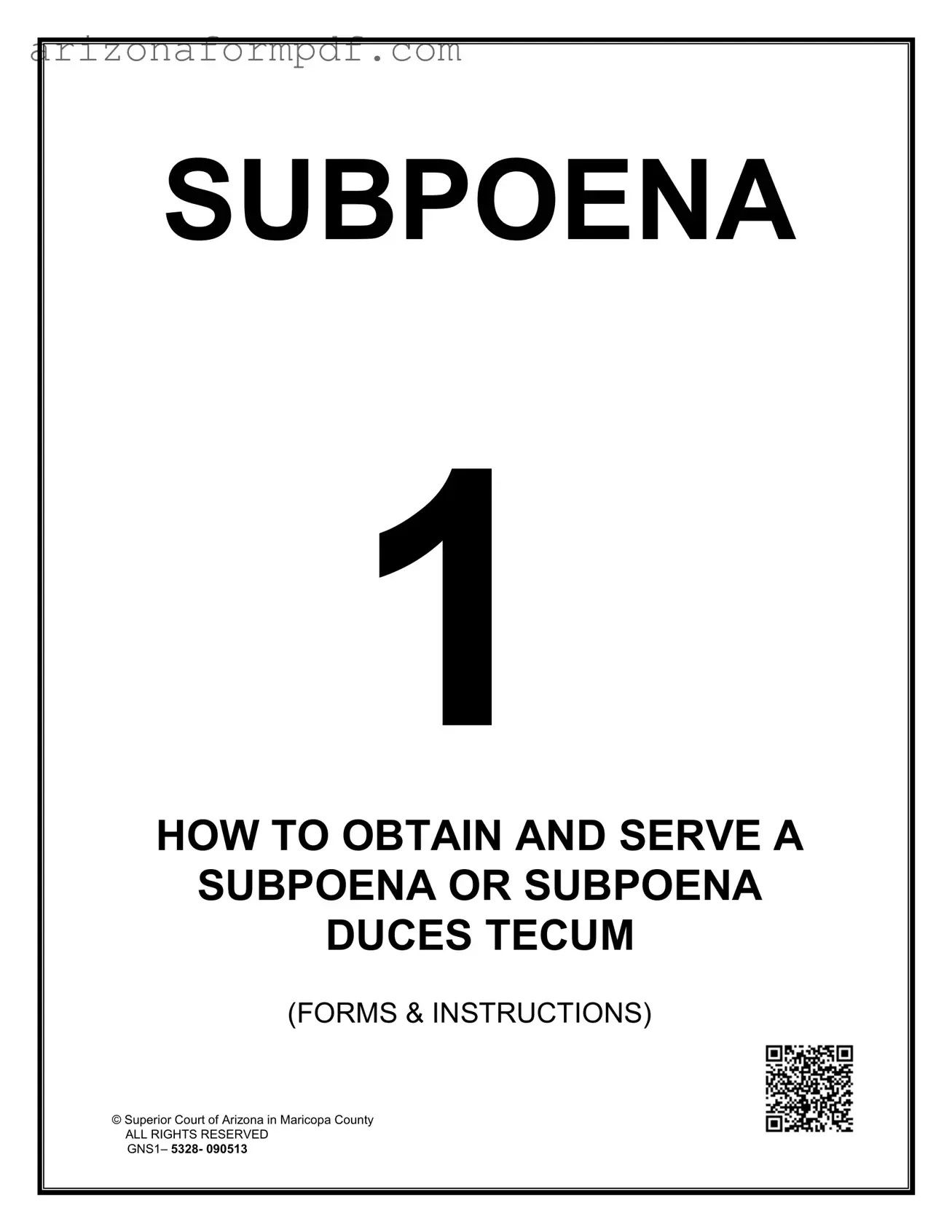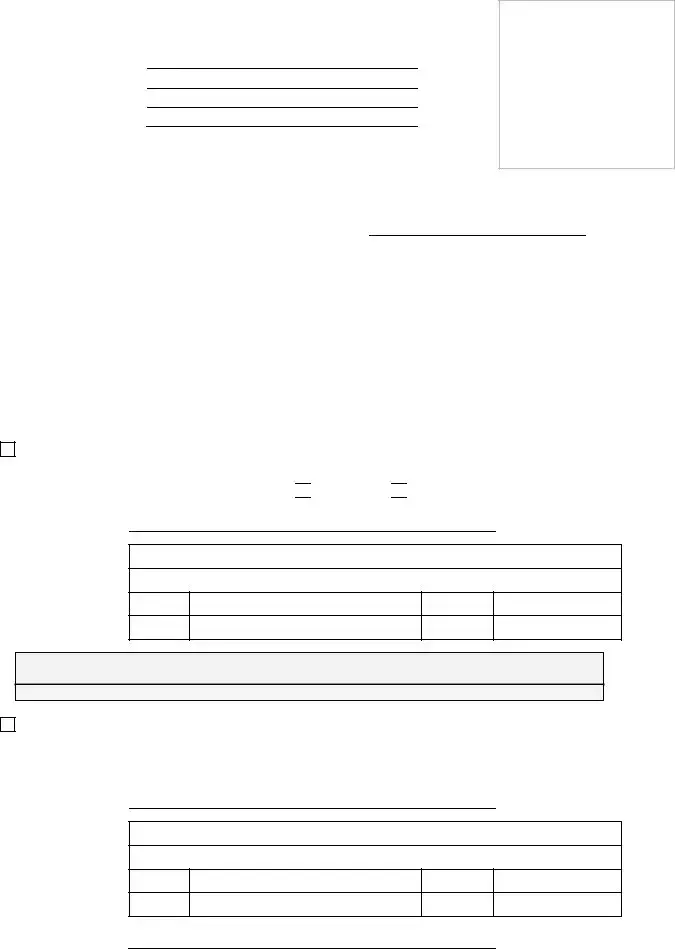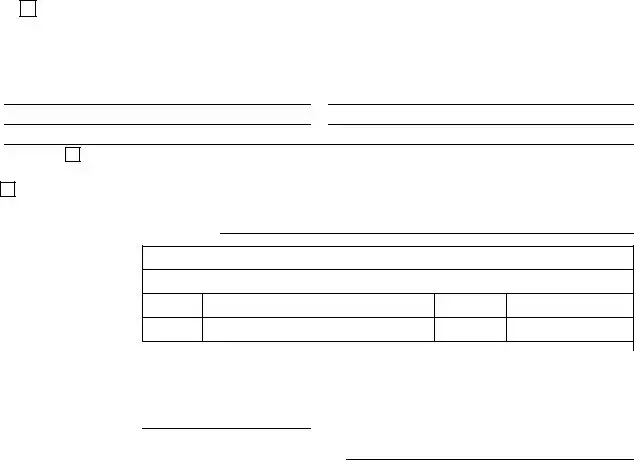SUBPOENA
1
HOW TO OBTAIN AND SERVE A
SUBPOENA OR SUBPOENA
DUCES TECUM
(FORMS & INSTRUCTIONS)
©Superior Court of Arizona in Maricopa County
ALL RIGHTS RESERVED GNS1– 5328- 090513
SELF-SERVICE CENTER
HOW TO OBTAIN AND SERVE A SUBPOENA
OR SUBPOENA DUCES TECUM
CHECKLIST
You may use the forms and instructions in this packet if . . .
You want a legal order summoning a witness to testify or submit evidence, or
You want a legal order for someone to produce or make documents, records or objects, or a physical location available for your inspection, AND
You have already filed and have a case open in the Superior Court, OR
You have already registered a foreign (out of state) case with the Maricopa County Clerk of the Court, AND
The person (or company or organization, etc.) to whom the subpoena is to be given is NOT a party to the case, AND
The person (or company or organization, etc.) to whom the subpoena is to be given will be served within the state of Arizona.
WARNING: There are additional requirements for requesting MEDICAL RECORDS by subpoena. Those requirements and additional forms that may be needed for that purpose are NOT included in this packet. Refer to Arizona Revised Statutes (online at www.azleg.gov )
§12-2294.01 or consult an attorney for additional information.
READ ME: Consulting a lawyer before filing documents with the court may help prevent unexpected results. The Self-Service Center has a list of lawyers you may hire to advise you on handling your own case or to perform specific tasks, and a list of court-approved mediators as well. View the lists at the Self- Service Centers or online at www.superiorcourt.maricopa.gov/SSC
© Superior Court of Arizona in Maricopa County |
GNS1k-051811 |
ALL RIGHTS RESERVED |
|
|
Page 1 of 1 |
SELF-SERVICE CENTER
SUBPOENA
This packet contains court forms and instructions to file a subpoena. Items in BOLD are forms that you will need to file with the Court. Non-bold items are instructions or procedures. Do not copy or file those pages!
|
Order |
File Number |
Title |
# pages |
|
|
|
|
|
|
1 |
GNS1k |
Checklist: You may use these forms if . . . |
1 |
|
|
|
|
|
|
2 |
GNS1t |
Table of forms and instructions (this page) |
1 |
|
|
|
|
|
|
3 |
GNS12p |
Procedures: How to Obtain and Serve a “Subpoena” |
2 |
|
|
|
|
|
|
4 |
GNS12i |
Instructions: How to Fill Out the “Subpoena” |
1 |
|
|
|
|
|
|
5 |
GNS12f |
“Subpoena” |
5 |
|
|
|
|
|
|
6 |
GNS12h |
Costs to Person Sending Subpoena |
1 |
|
|
|
|
|
|
7 |
GNS28f |
“Affidavit of Service” (only needed if served by person other |
1 |
|
than sheriff or licensed process server) |
|
|
|
|
|
|
|
|
|
The documents you have received are copyrighted by the Superior Court of Arizona in Maricopa County. You have permission to use them for any lawful purpose. These forms shall not be used to engage in the unauthorized practice of law. The Court assumes no responsibility and accepts no liability for actions taken by users of these documents, including reliance on their contents. The documents are under continual revision and are current only for the day they were received. It is strongly recommended that you verify on a regular basis that you have the most current documents.
© Superior Court of Arizona in Maricopa County |
Page 1 of 1 |
GNS1t -051811 |
|
ALL RIGHTS RESERVED |
|
|

PROCEDURES:
HOW TO OBTAIN AND SERVE A SUBPOENA
NOTE
•The subpoena is used to obtain testimony or the production of documents, records or objects, or the inspection of premises from persons or companies, organizations, etc., who are NOT parties to the case.
•You are responsible for the receiving party’s costs of complying with the subpoena. (See “Costs to Person Sending Subpoena” in this packet for more information.)
•You must already have an open case in the Superior Courts of Arizona for the Clerk to issue a subpoena, or have already registered the order of a foreign (out of state) court for a deposition. (See http://clerkofcourt.maricopa.gov/faxondemand/202.pdf )
•You must be able to serve the subpoena within the state of Arizona.
•WARNING: There are additional requirements for a subpoena of MEDICAL RECORDS. Those requirements and additional forms that may be needed for that purpose are NOT included in this packet. Refer to A.R.S. § 12-2294.01 or consult an attorney for additional information.
STEP 1 - COMPLETE THE SUBPOENA. (See separate “How to Complete the Subpoena”
instructions)
STEP 2: Take the original subpoena to the Clerk of the Superior Court. Pay the fee and have the form signed and dated by the Clerk between the hours of 8:00 A.M. and 5:00 P.M., Monday through Friday, at any of the locations listed below.
Locations of the Clerk of Court in Maricopa County
Central Court Building
Old Courthouse
Downtown Justice Center
Juvenile Court Center
N.E. Regional Court Center
S.E. Court Complex
N.W. Court Facility
|
(downtown Phoenix) |
201 W. Jefferson, Phoenix, AZ |
85003 |
|
(downtown Phoenix) |
125 W. Washington, Phoenix, AZ |
85003 |
|
(downtown Phoenix) |
620 W. Jackson, Suite 3017, Phoenix, AZ |
85003 |
|
(east of 35th Ave.) |
3131 W Durango, Phoenix, AZ |
85009 |
|
(40th St & Union Hills) |
18380 N. 40th St. Suite 120, Phoenix, AZ |
85032 |
|
(Hwy 60 south to S. Mesa Dr) |
222 E. Javelina, 1st floor, Mesa, AZ |
85210 |
|
(W on Statler, off Litchfield |
14264 W. Tierra Buena Lane, Surprise, |
85374 |
|
between W. Bell & Greenway) |
AZ |
|
|
As of April 12, 2011, the fee for issuance of each subpoena is $26 (subject to change). Go online to http://clerkofcourt.maricopa.gov/fees.asp or ask at the Self-Service Center for a list of current fees. Cash, VISA/MasterCard/AMEX debit or credit cards, money order, or personal in-state check made payable to the “Clerk of Superior Court” are acceptable forms of payment.
If you cannot afford the filing fee and/or the fee for having the papers served by the Sheriff, you may request a deferral (payment plan) when you file your papers with the Clerk of the Court. Deferral Applications are available at no charge from the Self-Service Center.
STEP 3 – MAKE COPIES: Make (1) copy for your records, plus (1) for every party in the case:
STEP 4 – MAIL ONE COPY to every party in the case.
© Superior Court of Arizona in Maricopa County |
GNS12p-051811 |
ALL RIGHTS RESERVED |
Page 1 of 2 |
STEP 5 - SERVE THE SUBPOENA.
Have the original subpoena served on (personally delivered to) the person you want to appear in court or for a deposition or who is in control of the documents, objects or location you want to examine.
The original subpoena may be served by any person over the age of 18 who is NOT a party to the case.
The person serving the subpoena must file an Affidavit of Service with the Court as proof of delivery.
If you choose to have the paper served by a licensed process server or the Sheriff’s Department, they will have their own Affidavit of Service form, if not, use the one included in this packet.
FREQUENTLY ASKED QUESTION (FAQ): WHEN MUST THE SUBPOENA BE SERVED? HOW FAR IN ADVANCE OF WHEN I WANT THE PERSON TO APPEAR OR THE DOCUMENTS, RECORDS, OBJECTS OR PLACE MADE AVAILABLE FOR INSPECTION MUST THE SUBPOENA BE DELIVERED?
ANSWER: The rules of court known as the Arizona Rules of Civil Procedure (A.R.C.P.) do not specify any particular number of days that the subpoena must be delivered before the person is to appear or the documents or objects delivered or place made available for inspection.
The Rules do say that if the person receiving the subpoena feels that the length of time is unreasonable or otherwise objects, he or she must file an objection with the Court within 14 days of receiving the subpoena or before the date listed on the subpoena for the person to appear or to produce or provide access to the documents, records, objects, or location listed on the subpoena. A.R.C.P. 45 (C)(5) Identical provisions are contained in Arizona Rules of Family Law Procedure (A.R.F.L.P.) Rule 52.
STEP 6 – WAIT and be prepared to respond to any objection from the party being served with the subpoena, or for the date and time the items are to be produced or for the scheduled appearance.
© Superior Court of Arizona in Maricopa County |
GNS12p-051811 |
ALL RIGHTS RESERVED |
Page 2 of 2 |
SELF-SERVICE CENTER
INSTRUCTIONS:
HOW TO COMPLETE THE SUBPOENA
A subpoena is a legal order summoning a witness to testify or submit evidence. A subpoena duces tecum is a legal order requiring:
1.the production of documents, records or objects, or
2.making documents, records or objects, or a physical location available for inspection.
(This packet may be used for either or both types of subpoena.)
TO COMPLETE THIS FORM YOU WILL NEED:
Your case number.
The name and address of the person you want to appear as a witness in court or at a deposition, or who is in charge of the documents, records, or place you want to examine (who is NOT a party to the case).
INSTRUCTIONS: PRINT CLEARLY. USE BLACK INK. If you have access to the Internet and a printer, you may also fill out the subpoena form for free online at the Self-Service Center’s web site at www.superiorcourt.maricopa.gov/ssc to print out a more legible typed copy.
•Fill in the information requested at top left for the person who is sending the subpoena. If there is a current court order declaring your address is protected, write “protected” on the line provided for your address. Make sure the Clerk of Court has valid contact information on file.)
•Fill in the “case caption” where it says “In the Matter of” and “Case Number” exactly as it appears on your original court papers.
•Fill in the name and address of the person (or company, organization, etc.) to receive the subpoena.
Check one or more of the boxes for sections “1”, “2”, and/or “3” to indicate whether the subpoena is being sent:
1.To order someone to appear to testify at a court trial or hearing.
2.To order someone to appear for a deposition at an attorney’s office (or other location) to answer questions or give testimony that will be recorded for possible use at trial, and/or
3.As a subpoena duces tecum to order someone to produce or allow inspection of documents, objects, or of a specified location.
Fill in the information requested for each section you indicated. Then refer to the “Procedures” document in this packet for information getting the subpoena, including the “Your Duties in Responding” section, delivered or “served” as required by law.
© Superior Court of Arizona in Maricopa County |
Page 1 of 1 |
GNS12i-051811 |
ALL RIGHTS RESERVED |
|
|
|
Person Requesting Subp:
Mailing Address:
City, State, Zip Code:
Telephone:
SUPERIOR COURT OF ARIZONA
IN MARICOPA COUNTY
In the Matter ofCase No.
|
|
SUBPOENA |
|
Petitioner(s) /Plaintiff(s) |
Arizona Rules of Civil Procedure, Rules 45, 84 |
|
|
|
Arizona Rules of Family Law Procedure, Rule 52 |
|
|
|
|
|
Respondent /Defendant(s) |
|
|
|
|
|
|
TO: Name: |
|
|
|
Address: |
|
|
|
|
|
|
City, State, Zip Code: |
|
|
|
|
|
|
|
|
|
|
(Check the box(es) to indicate one or more of “1”, ”2”, and/or “3”, below.)
For Attendance of Witnesses at Hearing or Trial:
Judicial Officer:
(at) Address:
Floor:
Date:
Request for reasonable accommodation for persons with disabilities must be made to the Court at least 3 working days in advance of a scheduled court proceeding.
YOUR RIGHTS AND DUTIES CONCERNING THIS SUBPOENA FOLLOW.
For Taking of Depositions:
YOU ARE ORDERED TO APPEAR at the place, date and time specified below to testify at the taking of a deposition in the case named above:
Place of Deposition:
(at) Address:
Method of Recording:
© Superior Court of Arizona in Maricopa County |
GNS12f-090413 |
ALL RIGHTS RESERVED |
|
|
Page 1 of 5 |
Issued this date:
the requesting party within the time allowed
Case No.______________________
SUBPOENA DUCES TECUM
For Production of Documentary Evidence or Objects or Inspection of Premises:
YOU ARE ORDERED to produce and permit inspection, copying, testing, or sampling of the following designated documents, electronically stored information or tangible things, or to permit inspection of the premises at the place, date, and time specified below:
Additional documents listed on attached page(s)
TO BRING WITH YOU to the court proceeding or deposition listed above, OR
Place of Production or Inspection:
(at) Address:
Floor:
Date:
YOUR APPEARANCE IS NOT REQUIRED if the items ordered to be produced are delivered to AND you are not otherwise ordered to appear.
Clerk of Superior Court
By:
Deputy Clerk
Your Duties In Responding To This Subpoena*
*See Arizona Rules of Civil Procedure (A.R.C.P.), Rules 45(b), (c), and (e), and Arizona Rules of Family Law Procedure (A.R.F.L.P.) Rule 52, and the “Your Right to Object to this Subpoena” section below.
ATTENDANCE AT A TRIAL: If this subpoena commands you to appear at a trial, you must appear at the place, date and time designated in the subpoena unless you file a timely motion with the court and the court quashes or modifies the subpoena. Unless a court orders otherwise, you are required to travel to any part of the state to attend and give testimony at a trial.
ATTENDANCE AT A HEARING OR DEPOSITION: If this subpoena commands you to appear at a hearing or deposition, you must appear at the place, date and time designated in this subpoena unless either:
(1)you file a timely motion with the court and the court quashes or modifies the subpoena;
or
(2)you are not a party or a party's officer and this subpoena commands you to travel to a place other than: (a) the county in which you reside or you transact business in person; or
(b)the county in which you were served with the subpoena or within forty (40) miles from the place of service; or
(c)such other convenient place fixed by a court order.
© Superior Court of Arizona in Maricopa County |
GNS12f-090413 |
ALL RIGHTS RESERVED |
|
Case No.______________________
PRODUCTION OF DOCUMENTARY EVIDENCE, TANGIBLE OBJECT, OR INSPECTION OF PREMISES: If this subpoena commands you to produce and permit inspection, copying, testing or sampling of designated documents, electronically stored information, or tangible things, you must make the items available at the place, date and time designated in this subpoena, and in the case of electronically stored information, in the form or forms requested, unless you provide a good faith written objection to the party or attorney who served the subpoena. Similarly, if this subpoena commands you to make certain premises available for inspection, you must make the designated premises available for inspection on the date and time designated in this subpoena unless you provide a good faith written objection to the party or attorney who served the subpoena.
You should note that a command to produce certain designated materials, or to permit the inspection of premises, may be combined with a command to appear at a trial, hearing or deposition. You do not, however, need to appear in person at the place of production or inspection unless the subpoena also states that you must appear for and give testimony at a hearing, trial or deposition.
If the subpoena commands you to produce documents, you have the duty to produce the designated documents as they are kept by you in the usual course of business, or you may organize the documents and label them to correspond with the categories set forth in the subpoena.
YOUR RIGHT TO OBJECT TO THIS SUBPOENA
Generally, if you have concerns or questions about this subpoena, you should first contact the party or attorney who served the subpoena. The party or attorney serving the subpoena has a duty to take reasonable steps to avoid imposing an undue burden or expense on you. The superior court enforces this duty and may impose sanctions upon the party or attorney serving the subpoena if this duty is breached.
PROCEDURE FOR OBJECTING TO A SUBPOENA FOR ATTENDANCE AT A HEARING, TRIAL OR DEPOSITION:
You must file a motion to quash or modify the subpoena with the court to obtain a court order excusing you from complying with this subpoena.*
The motion must be filed in the superior court of the county in which the case is pending or in the superior court of the county from which the subpoena was issued.*
The motion must be filed before the time specified for compliance or within 14 days after the subpoena is served, whichever is earlier.*
You must send a copy of any motion to quash or modify the subpoena to the party or attorney who served the subpoena.
The court must quash or modify a subpoena if . . .
(1)the subpoena does not provide a reasonable time for compliance;
(2)the subpoena commands your attendance at a trial and if the subpoena commands you to travel to a place other than:
(a)the county in which you reside or transact business in person;
(b)the county in which you were served with a subpoena, or within forty (40) miles from the place of service; or
(c)such other convenient place fixed by a court order; or
© Superior Court of Arizona in Maricopa County |
GNS12f-090413 |
ALL RIGHTS RESERVED |
|
Case No.______________________
(3)the subpoena requires disclosure of privileged or other protected matter, if no exception or waiver applies; or
(4)the subpoena subjects you to undue burden.
The court MAY quash or modify a subpoena if . . .
(1)the subpoena requires you to disclose a trade secret or other confidential research, development or commercial information;
(2)you are an unretained expert and the subpoena requires you to disclose your opinion or information resulting from your study that you have not been requested by any party to give on matters that are specific to the dispute;
(3)you are not a party or a party's officer and the subpoena would require you to incur substantial travel expense; or
(4)the court determines that justice requires the subpoena to be quashed or modified.
In these last four circumstances, a court may, instead of quashing or modifying a subpoena, order your appearance or order the production of material under specified conditions if:
(1)the serving party or attorney shows a substantial need for the testimony or material that cannot be otherwise met without undue hardship; and
(2)if your travel expenses or the expenses resulting from the production are at issue, the court ensures that you will be reasonably compensated.
PROCEDURE FOR OBJECTING TO SUBPOENA FOR PRODUCTION OF DOCUMENTARY EVIDENCE, RECORD, TANGIBLE OBJECT OR INSPECTION OF PREMISES:
If you wish to object to a subpoena commanding you to produce documents, electronically stored information or tangible items, or to permit the inspection of premises, you may send a good faith written objection to the party or attorney serving the subpoena that objects to:
(1)producing, inspecting, copying, testing or sampling any or all of the materials designated in the subpoena;
(2)inspecting the premises; or producing electronically stored information in the form or forms requested.
You must send your written objection to the party or attorney who served the subpoena before the time specified for compliance or within 14 days after the subpoena is served, whichever is earlier.
If you object because you claim the information requested is privileged, protected, or subject to protection as trial preparation material, you must express the objection clearly, and support each objection with a description of the nature of the document, communication or item not produced so that the demanding party can contest the claim.
© Superior Court of Arizona in Maricopa County |
GNS12f-090413 |
ALL RIGHTS RESERVED |
|









 Hearing
Hearing 
 Trial in the case named above, before:
Trial in the case named above, before: